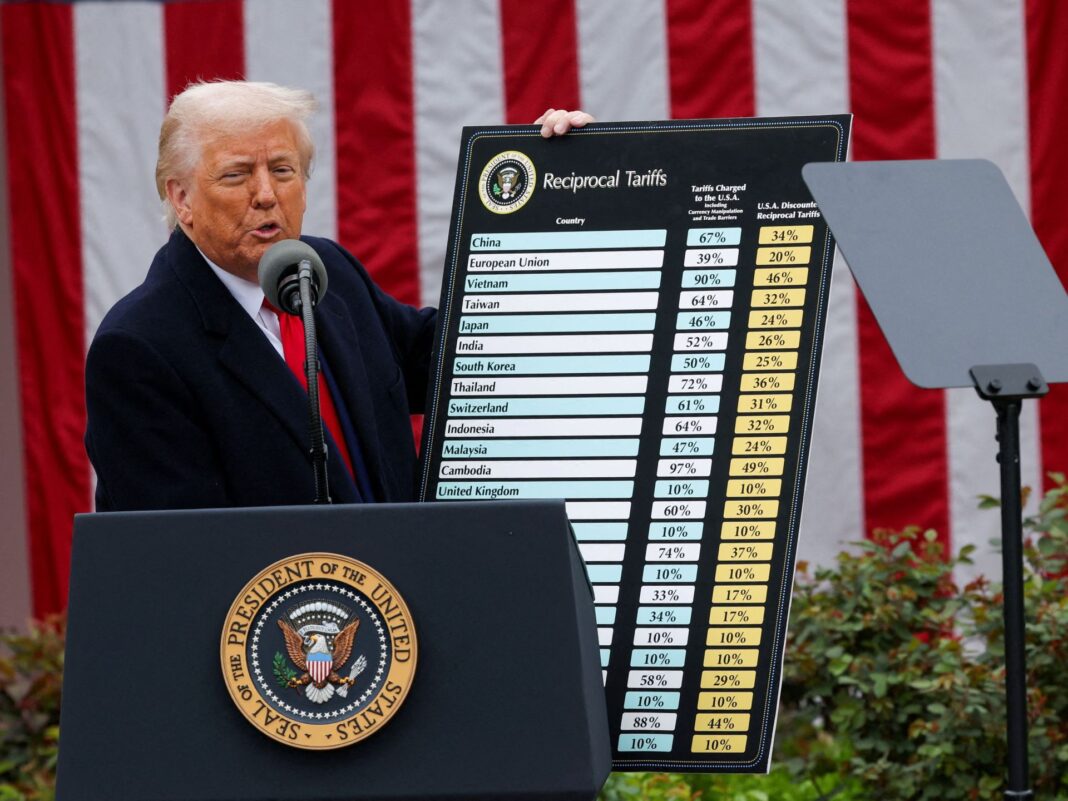On Wednesday, President Donald Trump announced a sweeping 10 percent global baseline tariff on almost all imports to the United States, claiming the move marks the “Liberation Day” of the US economy. The policy is, however, as pro-US as the People’s Liberation Army of China. If maintained, the tariffs will prove extremely damaging to the US economy, the American consumer, and the country’s standing in the world.
The 10 percent tariff is remarkably the baseline; Trump’s efforts to liberate the US economy include numerous far higher tariffs. One example is his 25 percent tariff on all automotive imports that came into effect on his “Liberation Day”. Trump claims that his policy is aimed at restoring the US manufacturing base, but there is no time to rebuild this capacity at a light-warp speed. Trump, of course, pays such concerns little heed. An identical 25 percent tariff on automotive parts is delayed only for a month and will come into effect in May. Automotive prices will spike, and supply chains will jam up.
The US is the most car-dependent major economy – a larger share of voters will be directly hit by the move than in any other Western country. Trump’s March tariffs on Canada and Mexico – the two countries with whom most US automotive manufacturing is integrated – have already caused disruption. There is a near-universal anticipation that prices will rise.
But this trend will play out across numerous other supply chains as well. Many of the closest allies of the US face higher tariffs – goods from the European Union will face a 20 percent blanket tariff. Japanese exports to the US will be taxed at 24 percent. Those from Taiwan, whose supply of chips is so critical to the US technology industry, will be taxed at 32 percent. India and Vietnam, two of the countries to which US supply chains have been most re-routed since Trump’s first administration began with a much sharper focus on the US-Chinese trade imbalance, face a 26 percent and 46 percent tariff, respectively.
The US is ill-prepared for an inflationary shock. It is still fighting off the last inflation shock caused by the “bullwhip” effect from the seizing up of global supply chains during the COVID-19 pandemic, and the international economic reverberations of Russia’s 2022 full-scale invasion of Ukraine. The inflationary impact of Trump’s tariffs will be felt sooner rather than later, even as some of his team are scrambling to claim there will be negotiations on lowering some of the tariffs. This is because importers and distributors will have to reassess the profitability of the goods they are ordering now. Supply chains may well be further disrupted by countermeasures from the countries affected.
While there is no doubt that the era of global free trade that Washington did so much to usher in under previous presidents has seen the country’s share of manufacturing decline, it is the US consumer who has been perhaps the greatest beneficiary of that agenda. They will be the main losers of Trump’s policy.
Trump bemoans the bipartisan consensus that was in place before his rise, deriding the “globalists” who supposedly drove this agenda and, in his view, the stock market’s strong negative reaction to his abrogation from the idea of ever-freer trade. But the great irony is that it was his Republican Party that did the most to drive this agenda forward.
In the 1980s, President Ronald Reagan put trade at the centre of his message of prosperity, for both the US and those who would partner with it. Milton Friedman, traditionally an economist highly lauded by conservatives and a Reagan adviser, wrote: “Our tariffs hurt us as well as other countries. We would be benefited by dispensing with our tariffs even if other countries did not … There are few measures we could take that would do more to promote the cause of freedom at home and abroad.”
Reagan’s Democratic opposition were late converts – when Bill Clinton brought the North American Free Trade Agreement before Congress in 1994, more Republican senators voted for it than Democrats. Trump, however, does not plan on having any kind of congressional oversight over his latest plans, however – even where they appear to run counter to free trade agreements with affected countries.
However, Congress can still fulfil its role.
Trump’s tariffs rely on relatively thin standing. Namely, he claims he is enacting them out of “national security grounds”. Formally, he justifies them under the 1977 International Emergency Economic Powers Act (IEEPA). The half-a-century-old Act is among the most influential pieces of US legislation in history, as it allows for significant expansion of the power of the executive branch. It sits at the core of the authority to issue sanctions as well as for imposing restrictions on the export of US technology, as well as many of Trump’s previous tariff acts.
For the president to use these powers, however, he must declare an underlying national emergency and provide justification for it. Although it has never done so, Congress does have the power to terminate a national emergency declared under IEEPA through the National Emergencies Act of 1985.
A vote on rescinding has already been held in the US Senate. Hours after Trump announced his tariff onslaught, four Republicans – Susan Collins of Maine, Lisa Murkowski of Alaska and both Kentucky senators, the former majority leader Mitch McConnell and Rand Paul – joined all Democrats in voting for a resolution to rescind the “national emergency” on fentanyl that Trump issued to justify his blanket tariffs on Canada, passing it 51-48. But with this action only the Canadian order, not the similar order underpinning Trump’s tariffs on Mexico, was targeted. This highlights how bleak the political outlook is for the immediate reversal of Trump’s latest, far costlier, tariffs which were enacted on the back of a different “national emergency” tied to trade deficits.
Any resolution to rescind Trump’s national emergencies and reverse his tariffs can come into effect only if it withstands his veto, which requires a two-thirds majority in both the Senate and the House of Representatives. The House’s Republican leadership is not expected to allow a vote even on the Senate’s Canada resolution, let alone a future resolution that would affect Wednesday’s tariffs.
Congress today is not geared up to do what is necessary to reverse Trump’s destructive plan.
Some Democrats began to shift away from the embrace of free trade under the Biden administration, recognising that while it had its benefits, it does have its costs too and that a rebalancing is necessary. The Republican Party, on the other hand, had no gradual change of orthodoxy. It has been wholly transformed since Trump came to establish dominance over it eight years ago. It is almost impossible for a two-thirds majority against Trump tariffs to be achieved.
Nonetheless, everything must be done to open the eyes of those in Congress and convince them to do what is right.
The economic costs of Trump’s tariff actions will soon become clear. But as opposition outside Congress mounts – whether that be from the US consumer, stock market, or the courts – Trump will shatter more norms to try to protect his trade agenda.
April 2025 can still herald US liberation, but only if Congress liberates the country from the tyranny of rule by “national emergency”.
The views expressed in this article are the author’s own and do not necessarily reflect Al Jazeera’s editorial stance.


